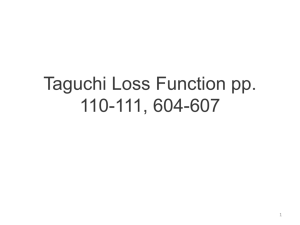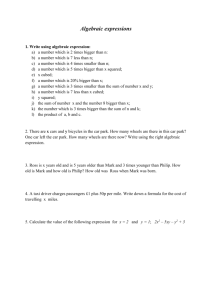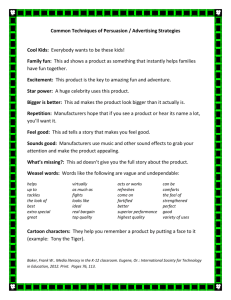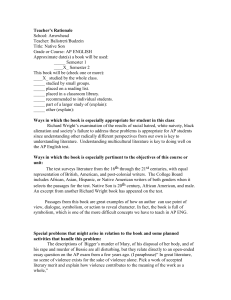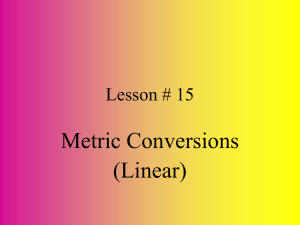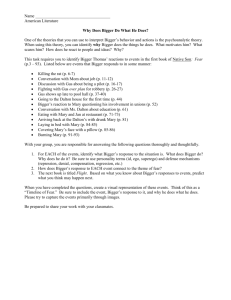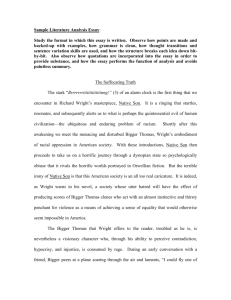Example Dialectical Journal 4
advertisement
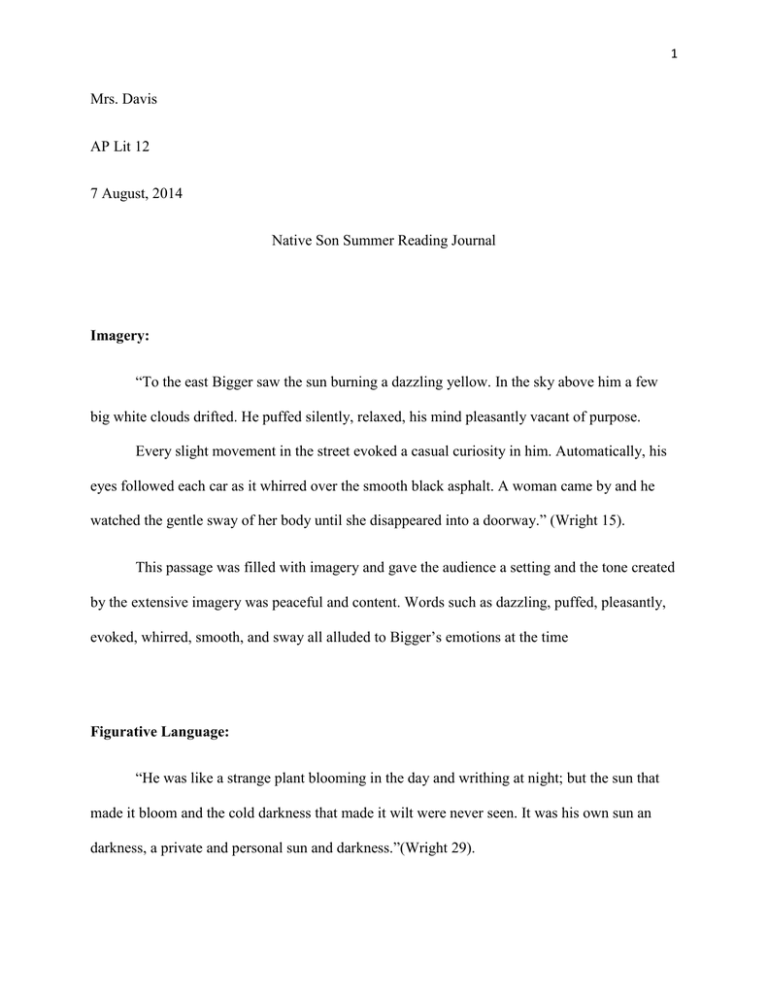
1 Mrs. Davis AP Lit 12 7 August, 2014 Native Son Summer Reading Journal Imagery: “To the east Bigger saw the sun burning a dazzling yellow. In the sky above him a few big white clouds drifted. He puffed silently, relaxed, his mind pleasantly vacant of purpose. Every slight movement in the street evoked a casual curiosity in him. Automatically, his eyes followed each car as it whirred over the smooth black asphalt. A woman came by and he watched the gentle sway of her body until she disappeared into a doorway.” (Wright 15). This passage was filled with imagery and gave the audience a setting and the tone created by the extensive imagery was peaceful and content. Words such as dazzling, puffed, pleasantly, evoked, whirred, smooth, and sway all alluded to Bigger’s emotions at the time Figurative Language: “He was like a strange plant blooming in the day and writhing at night; but the sun that made it bloom and the cold darkness that made it wilt were never seen. It was his own sun an darkness, a private and personal sun and darkness.”(Wright 29). 2 This passage demonstrates how Bigger views himself poorly and because of society he puts himself down and causes his own darkness that inevitably gets the best of him. His sun is when he is happy in those moments at the poolroom or watching a movie. However his darkness is created by the white society who makes him scared and angry about is inequality and the disadvantages; which was also illustrated within the first 20 pages when Bigger was “playing white”. Character Development: “Gus did not move a muscle. Bigger pushed the knife harder into Gus’s stomach… ‘You clown,’ he said. ‘Put your hands down and set on that chair.’ He watched Gus sit. ‘That ought to teach you not to be late next time.’” (Wright 39). In this scene, Bigger threatens Gus and acts out violently because Gus was late. This is the first time the audience see’s Bigger act out violently towards another human. At this point you can characterize Bigger as a bully and an immoral character. Sympathy isn’t felt towards Bigger. If anything a feeling of hatred towards him is created because he is acting childish and scared. Imagery: “Then he began to cut the green cloth on the table with long sweeping strokes of his arm. He never took his eyes form Doc’s face.” (Wright 41). 3 Again this imagery shows how Bigger’s character is violent and a bully. Doc is nothing but a good host to the band of hooligans and Bigger acts out and trashes his pool table. Yet another example of how Bigger is an immoral character. Symbol: “The man stopped abruptly. Bigger paused, bewildered; then he saw coming slowly toward him a tall, thin, white woman, walking silently, her hands lifted delicately in the air and touching the walls to either side of her. Bigger stepped back to let her pass. Her face and hair were completely white; she seemed to him like a ghost.” (Wright 46). This passage is a description of Mrs. Dalton the first time Bigger enters the Daltons house. To me this passage is symbol of how Bigger sees the “white” world as all white. Later in the passage a white cat is following Mrs. Dalton and Mrs. Dalton has “long, white fingers.” Ultimately this begins to symbolize the theme of racism and segregation. Character Development: “But they made him feel his black skin by just standing there looking at him, one holding his hand and the other smiling. He felt he had no physical existence at all right then…” (Wright 67). Bigger is describing being with Mary and Jan and how he is uneasy and ashamed to be around them (white people) when they are being so nice to him. Bigger has moved from being a 4 violent bully to an uneasy, confused, blank black boy, who is actually trying to keep his job. This shift shows Bigger becoming more responsible rather than immoral. Imagery: “Frantically, he caught a corner of the pillow and brought it to her lips. He had to stop her form mumbling, or he would be caught. Mrs. Dalton was moving slowly toward him and he grew tight and full, as though about to explode. Mary’s fingernails tore at his hands and he caught the pillow and covered her entire face with it, firmly. Mary’s body surged upward and he pushed downward upon the pillow with all of his weight, determined that she must not move or make any und that would betray him.” (Wright 85). The imagery included in the passage above not only depicts the morbid act of Bigger killing Mary but sets a frantic and suspenseful tone. The imagery also shows that Bigger is scared he will be caught because he knows that it will be assumed that he raped her or was going to rape her. His fear, caused by oppression and racism, led to him murdering a helpless girl and eventually another girl too. I would say this scene is the rising action and is leading to more character development and depicts the main themes more. Style: “He stood with her body in his arms in the silent room and cold facts battered him like waves sweeping in from the sea: she was dead; she was white; she was a woman; he had killed 5 her; he was black; he might be caught; he did not want to be caught; if he were they would kill him.” (Wright 89). Bigger comes the sudden realization of what he has done like a sudden epiphany. Wright makes it obvious that Bigger is coming to this realization and is upset by using short, choppy sentences with the use of the semi colon. The statements are a simple subject verb pattern and clearly depict Bigger’s thoughts as upsetting. Style: “Jan and Mary were sitting in the car, kissing. They said, Good night, Bigger….And he said, Good night…. And he touched his hand to his cap….” The italics were used to emphasize Bigger’s thoughts and how he was creating an alibi for himself. This also shows Bigger’s panic and paranoia of being caught. Tone: “His heart raced; his lips parted; his legs trembled. He struggled to come fully awake. He relaxed his taut muscles, feeling fear, remembering that he had killed Mary, had smothered her, had cut her head off and put her body in the fiery furnace.” (Wright 97). As the plot thickens the tone gets increasingly suspenseful and urgent. In this passage the words taught, raced, parted, trembled, smothered, and fiery all cause a sense of fear and suspense within the audience. 6 Symbol: “It was white and cold. Snow was falling and an icy wind blew.” (Wright 99). Although only a few sentences snow is a symbol throughout the novel starting at the beginning of book 2 right after Bigger kills Mary. At the beginning it’s a light snowfall but by the end it’s a blizzard. The snow symbolizes how Bigger is trapped in his actions and feelings and cannot escape the white society. Character Development: “He felt that he had his destiny in his grasp. He was more alive than he could ever remember having been; his mind and attention were pointed, focused toward a goal.” (Wright 149). Bigger has yet another character shift towards fulfillment and goal oriented success. It is safe to say that this part of the novel is the climax for character development and also the turning point before Bigger becomes dark and sullen again. Along with his new sense of fulfillment the tone changes towards more uplifting and driven vocabulary. Figurative Language: “He heard the fire singing in the furnace.” (Wright 154). The fire singing in the furnace is a personification of fire but also illustrates Bigger’s guilt “singing” to him for burning Mary’s corpse. Figurative Language can be used not only as a 7 comparison or illustration but can be a symbol for a deeper meaning. This reminds me of 4th grade when I read the book, On My Honor. He swore, on his honor, that he would go straight to the park and not into the river but his friend convinced him and his friend drowned. Ashamed and scared he didn’t tell his parents or his friend’s parents but from that point on all he could smell was fish and the river, which he didn’t actually smell it was just his guilt. Tone: “He wanted to drop the brick, wanted to be free of this warm blood that crept and grew powerful with each passing moment. Then a dreadful thought rendered him incapable of action.” (Wright 237). The tone yet again turns bleak and dark with words such as crept, dreadful, rendered, and incapable which depicts Bigger’s mood. At this point Bigger is murdering Bessie and the Climax for Character development has passed and is starting the falling action. However, the climax for the novel has yet to happen. Tone: “Maybe he was just unlucky, a man born for dark doom, an obscene joke happening amid a colossal din of siren screams and white faces and circling lances of light under a cold and silken sky.” (Wright 275). Again the tone has become depressing and despairing with all the words pretty much but specifically obscene, colossal, silken, cold, and dark. Bigger has definitely hit the falling action of the book and of the character development. Bigger has become hopeless about his future. 8 Character Development: “He was ashamed of what he had done; he should have been honest with them.” (Wright 297). As Bigger comes into the falling action of character development he becomes ashamed of his actions and ultimately he is ashamed that he is black and couldn’t help his family because of oppression and racism that was found in the 1930’s. Theme: “Your Honor, another civil war in these states is not impossible; and if the misunderstanding of what this boy’s life means is an indication of how men of wealth and property are misreading the consciousness of the submerged millions today, one may truly come.” (Wright 403). As I was reading the novel this is the one quote that I thought truly illustrates oppression and racisms effects on the community. Essentially Max is calling out the Judge and men of wealth, meaning white men, for misunderstanding what another man’s life means because of his color. This quote encompasses the entire theme of the novel: oppression of races in the 1930’s. Character Development: “He knew he did not have a chance; he believed it.” (Wright 403). Bigger has come to the conclusion that he will not win the trial because he is black and because he killed two women, of which one was white. The italicized word, “believed”, shows 9 that Bigger didn’t just have assumptions or a gut feeling that he would lose the trial but he was fully convinced that he was condemned and given up even before the conviction. Theme: “You cannot kill this man, Your Honor, for we have made it plain that we do not recognize that he lives! So I say, ‘Give him life!’” (Wright 404). Max again argues that racism and oppression – the main themes in the novel- have caused Bigger to live a life without truly living and that punishing him to a lifetime of prison would be giving him more than he had ever had in life. This point in the book the audience now sympathizes with Bigger because he never had a fair chance in life. \ Symbol: A little symbol, that I do not have a passage or quote for because it was found all over the place in the book, is Mrs. Dalton’s blindness. Her blindness symbolizes the white society’s blindness to the other races and the oppression that is so very blatant to others. 10
